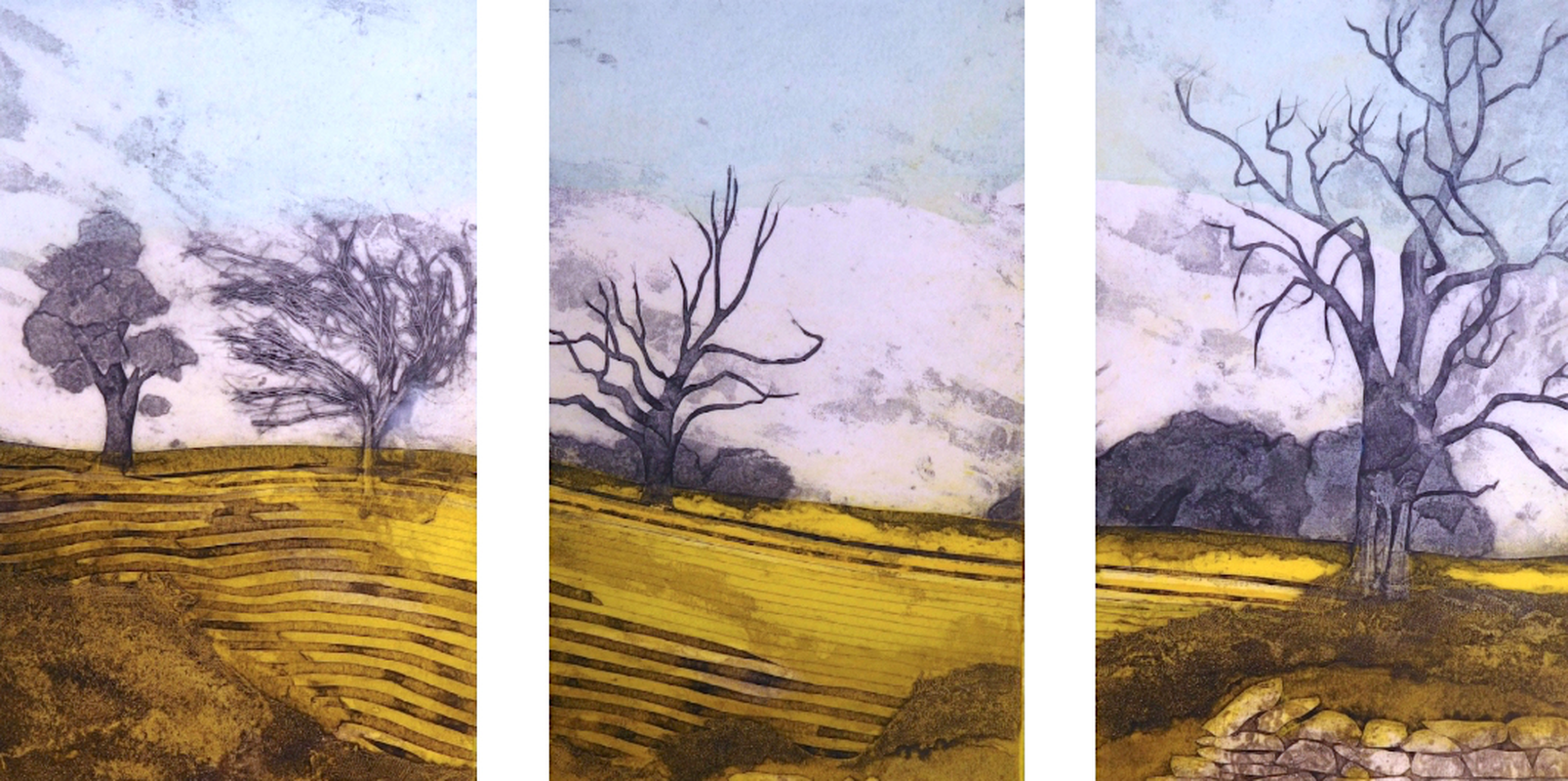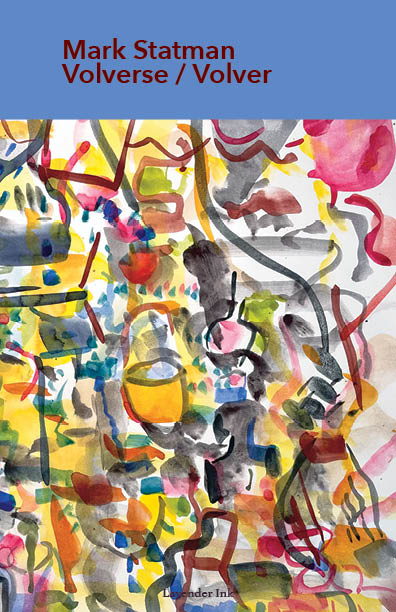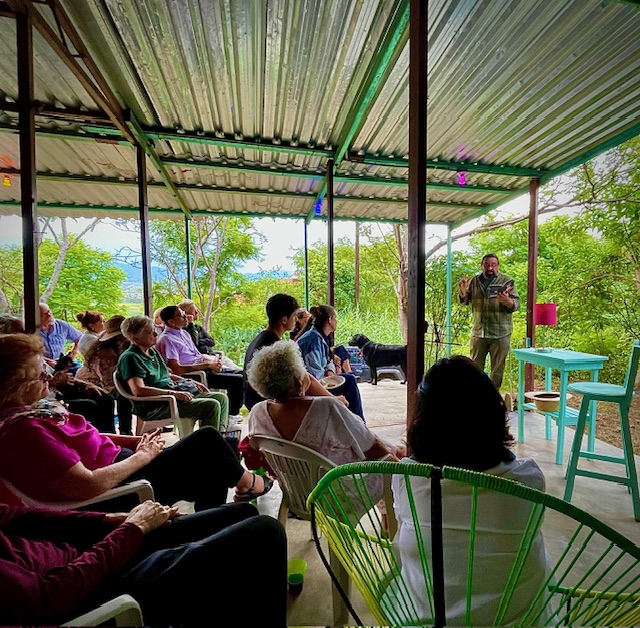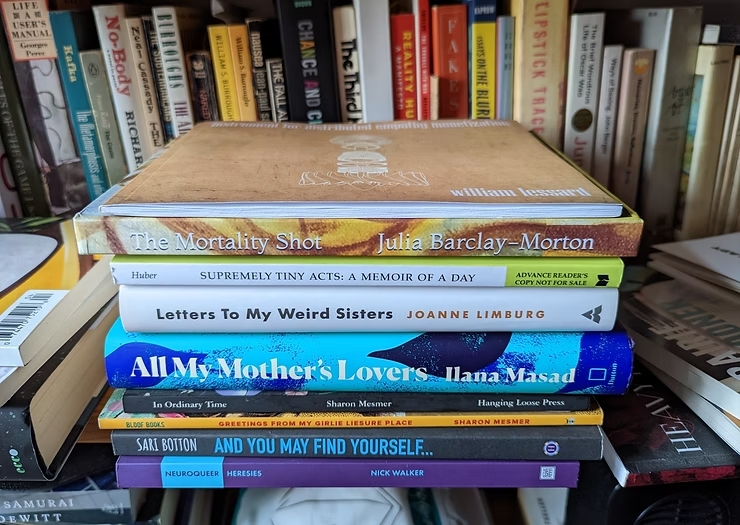
SARAH ROSS-THOMPSON AND THE ART OF COLLAGRAPHED PRINTS
I interviewed artist Sarah Ross-Thompson whose exceptional Collagraphed prints use fabrics, lichen, porridge and string to create images of the dramatic Scottish Highlands where she

I interviewed Line Langebek, Emma Adams and Tarnia Mason about the Dissonant Futures Collective – a creative group of people who take climate grief as the central theme to their work. I invited them to describe how the collective works and the community projects they’ve been involved in so far, including their Loss and Found sound installation, discussion groups and virtual reality workshops.
Leslie: Why is the collective called ‘Dissonant Futures Collective’, please?
Line Langebek: The name came from a meeting between collective members, a brainstorming session with lots of ideas for something which would somehow capture the topic of what we were discussing, circling and creating around, but also perhaps arouse curiosity. And something that might capture the uncertainty of what we were and are sitting with. In the end we took a vote! There were a few name ideas floating around.
Leslie: Who are your main collaborators and what have been the main outreach activities you’ve been involved in?

Line Langebek: In London we worked with the Albany in Lewisham, with the ‘Meet Me at the Albany’, a group for the 60+ that meet weekly. We joined the group one morning, together with artist in residence, Bernadette Russell, and talked about climate change and the group’s daily lives, as well as objects they had brought to the session. We also played with virtual reality experiences. At Birmingham Open Media, collective members ran drop-in workshops where participants could try the virtual reality experience The Shape of Us (developed by HeartWire in Germany, another collaborator). At all these sessions we recorded conversations with participants that also fed into the Loss and Found sound installation.
Emma Adams: In Bradford, Common Wealth Theatre Company provided the venue for our Loss and Found workshop. Rebecca and I ran a session with local people exploring and sharing our experience of climate grief/ what it means to us as individuals. Parts of the captured conversation went on to become material that was used to build the sound memorial. Common Space (the theatre’s venue) was also the venue for the Sound Memorial when it toured here.
Bradford Community Broadcasting and Racial Justice Network got involved later in the process. We organised a creative response with people at Bradford Community Broadcasting and Maureen Grant who is part of Racial Justice Network. My involvement on the day itself sadly had to be cancelled as I got Covid. But the exchange of ideas and collaboration between Mary Dowson, Line and Angela went ahead without me. A creative day that led to a sharing at Common Space and a radio show on BCB where Maureen and another Racial Justice Network member talked about the sound memorial. They used it as a springboard to discuss the need to prioritise/centre climate justice and to find the solutions for climate breakdown.
Leslie: Can you briefly explain what Loss and Found is, please:
All: Loss and Found is a sound installation, which consists of five structures (four tall pillars plus a ‘sea anemone – the subwoofer) plus a sound arrangement that plays from a 4.1 speaker system. The sound arrangement is a 20 minute long arrangement that plays on a loop. You can hear the stereo version of the arrangement here.
Leslie: How was it put together?
All: The Dissonant Futures collective first came together during lockdown in 2020. It had started initially as conversations between Sarah Ticho and Line Langebek, around the topic of virtual reality and climate and grief, and between Emma Adams and Line Langebek, around climate grief.
An initial zoom was set up that included Sarah, Emma and Line, plus also Tarnia Mason, Baff Akoto, David Alexander, Gudrun Soley and Rebecca Kenyon via Line and Anna Firbank via Sarah, where some people had met in person before and many hadn’t. The initial conversations made it clear that we needed to start with something other than a huge virtual reality project and the idea emerged to work with sound and to use participant workshops around the country in order to provide space to listen and explore. We also discussed the need for a manifesto (see here) and that we wanted to avoid setting up stall as ‘experts’, which we had seen too often in similar spaces. The collective was later joined by creative producer Clare Moloney, who came on board to co-produce with Anna Firbank, and the curator and artist Angela YT Chan, who first joined our BOM workshop in Birmingham, and later Bradford, providing different and invaluable perspectives.
We set up ‘subgroups’ of the collective, which developed and explored how to best run the workshops, using the knowledge within the collective, plus another group started to explore how the sound installation might look and what it could be. We wanted to remain open to feeding the workshop recordings into the development of Loss and Found, so once we started working on it in earnest it also required the sound designers who by then had joined (Camilo Tirado and Andrés Saenz) and installation designer (Kevin Logan, also with sound expertise) to be flexible to this way of working.
But for about a year, before we received funding from Arts Council England, we developed slowly, gradually, meeting monthly over zoom, and once (for some of us) in real life to explore, try virtual reality, talk and talk some more.
More collaborators began to join and be lined up then too, as we were preparing to find funding: Ellie Harrison from The Grief Series in Leeds, Anna Mauersberger from HeartWire in Germany, Mikkel Krause, a cultural grief researcher from Copenhagen and Kinda Studios, a neuroaesthetic studio – based in London.
Our conversations as we developed it went far and wide – but they always circled back to what would it sound like, this uncertainty we’re all sitting with, how do we capture this schism between the past and the present and the future, and between technology and nature (or is there a schism). And we also talked about the body and about awe – this came up in particular in our workshop with Kinda Studios. We remember how we feel much more than anything theoretical we heard or read. How do you create that in a physical experience? So that was part of the thinking experience – to work with ‘awe’ without perhaps just using ‘scale’ (which costs) but do it with sound. Our work to develop our website alongside all of this also fed into it. We worked with artist and website designer Kaixi Yang and her collaborator Christian Dion-Sims, to create a website that reflected who we are as a collective and the work we were trying to do – but also what is to come. Invariably, those conversations with Kaixi across continents, discussing shapes, colours, sounds and ethos, fed into our thinking around the sound installation too.
Leslie: How has it been exhibited?

All: To date, the sound installation Loss and Found has been exhibited at the Albany in Lewisham (outside in the Albany gardens), at Common Space in Bradford (inside) and at The Hidden Gardens in Glasgow, outside. The sound arrangement played on a loop at all venues, switched on daily by venue staff.
Leslie: How have the people who have experienced the exhibition fed back and contributed to it?
All: Loss and Found has been experienced in different ways in the different locations – each place has added to the installation too. At the Albany it was outside, on view from the cafe and you’d pass it as you exited to enjoy the gardens and perhaps also take in other things on sight. We joined the Meet Me at the Albany group again after the installation was up to experience it with them – some of their voices are part of the sound arrangement – and it was very joyful to listen to it and walk around it with them. At The Hidden Gardens in Glasgow it was also outside, but in a very different space. One of our collective members, Gudrun Soley spent an afternoon in the gardens, watching people as they engaged with it. In Bradford, it was inside, at Common Wealth, and whilst it had opening hours for the public to access it, it was also part of the space where people would come to work. All three spaces added something different to the installation and gave it new meaning.
Leslie: What do people experience in your virtual reality sessions and how does that engage with climate/eco/social justice breakdown and the resulting grief?
Line Langebek: The VR experience that we used, particularly in Birmingham and to some extent in Bradford was called ‘The Shape of Us’ – a 20-minute immersive experience created by HeartWire in Germany, who we met online during our development phase and discussed how to use their experience as part of our workshops. The Shape of Us takes you through human history from the past to a potential future (briefly!) and as it requires lots of movement and some crawling on the floor, we didn’t use it at the Albany where our group was much older and not all so mobile. Instead, at the Albany, they tried different, shorter nature VR experiences that could be experienced sitting in a chair. For The Shape of Us it provoked conversations about climate breakdown and also the wider conversation of social justice. Both for us and for HeartWire (having worked with The Shape of Us in Germany too, with young people too) it became clear that in a VR experience you want to have some impact beyond the ‘entertainment’ or temporary experience. It needs to sit inside an accompanying conversation too. The VR experience can’t do it all – just as a ‘grief’ isn’t always the right place to start, it’s not always where people are at.
Leslie: What are the formal and informal ways of working/relating that help you function well as a collective?
Line Langebek: From the beginning we created regular meetings on Zoom – because of where everyone were based (all over the U.K., one abroad, people sometimes travelling) we had to work this way, and then there were of course the added impact of the pandemic. But we also from early on decided we would think about a ‘manifesto’ – suggested by collective member Emma Adams, and aided by The Gries Series’ Ellie Harrison who had worked with collective of creatives in different contexts – and get everyone to contribute thoughts about how they’d like to work and where their interests in the project lay. We were and are a lot of people and not being able to be in a room together was a challenge. Online working is a gift, but ultimately you also want to be in the same space. We have still not all met at the same time, but have in smaller groups at different times, of course.

Leslie What are you working on now? What challenges/rewards does it/do these new projects bring?
Emma Adams: I’m beginning to dream up a personal response to the work we’ve done so far in this 1st phase of research and development / Loss and Found. I’m interested in thinking a bit more personally about my own climate grief in this response. It has been interesting to me that during this phase of research and development (almost by necessity, because we’ve had to be outward facing) that I’ve not often stopped to really think about my own climate grief. The exception was when we did the workshop in Bradford and then it all came flooding in for a brief while, which turned out to be ok though a little overwhelming too. But it was a powerful experience to share the thoughts and feelings I had with the people at the workshop. But by and large, when I’ve been doing the Dissonant Futures Collective work I’ve tried to be quite focused on developing ideas and strategies. I’ve been in ‘producer/pragmatic’ mode. But of course it’s super important/necessary to process this stuff and reflect upon it. So, I’m beginning to look at creating a zine about trees and nature, because I love them but I also feel huge grief when I walk and move through the woods where I live. I also want to reflect a bit about how climate grief for me is focused on nature. Which in one sense I feel glad about because I believe that human beings have a deep responsibility to protect nature. But, I also feel like the work I’ve done with Dissonant Futures Collective this year has crystalised the importance of thinking about all we do through the prism of climate justice. That it’s impossible to protect nature if we don’t embed true, challenging and system-changing justice for the humans most affected by climate change. And, of course, it’s not possible to protect humanity if we don’t protect and nurture nature. Humans and nature are so often posited as being ‘stand alone’ and in conflict. But I am thinking a lot about how trees look like they stand alone and yet we have more and more knowledge that they form community and interconnectedness via their roots. So that’s where I’m at with the work right now. I think the challenge/reward of this work is that I’m nervous but also excited to start to bring my creative self fully to the collective and share that side of what I do with the team. I have hopes that these individual responses will also hold the seeds of conversation that point to what will happen next, too. We’ll see.
Tarnia Mason: I’m really excited about the opportunity to connect with others exploring and campaigning in this space. There are so many brilliant, switched on activists I think we can learn a huge amount from. I’m also looking forward to continuing to engage people in conversation about the subject of climate change and how that reality feels. It’s really important to me that we’re not trying to necessarily educate people on this topic, we’re not experts, we’re all learning and figuring out how to navigate this reality. What we’re most interested in doing as part of this collective is to facilitate open and honest conversations and hear what it is people are thinking and experiencing. I’ve loved the conversations I’ve been part of so far, both as a group and also with the people outside of it we’ve worked with and I hope there will be more in this coming year.
Line Langebek: As this first project phase is coming to an end, with people working on their individual creative responses, we’re also gearing up to talk about the next phase – which might involve virtual reality… This will be a bigger undertaking than the project we’ve just completed, so we’ll need to get the funding in place first of course. We’ll see what happens next…

Leslie: Finally, what would you pick out about the Dissonant Future Collective that makes it (as in your nomination) ‘one of the most innovative community arts projects across Europe’?
Line Langebek:: We’re not sure we are! But I suppose the quest to figure out how to speak about this – or maybe to realise that speaking about grief directly isn’t always useful – to set sail as explorers rather than experts, to paraphrase a sentence from our manifesto, makes us – we hope – part of a broader conversation. But ‘the most innovative’, we’re not sure…
Emma Adams: I don’t know how we might begin to prove this! And it makes it sound like we are in a race of some kind with other arts organisations. Having said that, we are, of course, in a race to try and become useful in this conversation about climate grief, yes. Attempting to be innovative is part of that, but ‘one of the most innovative?!?!’ But this is perhaps also an insight into how a collective works at the beginning of its life, when it is attempting to be truly dynamic and representative of everyone’s ideas! Sometimes we don’t agree. Also, and this is something I have found useful about trying to respond to your questions / reflecting on them – I think our sense of ourselves – our mission & ideas about what we can and can’t do – are evolving. I think, now, over a year into (and coming to the end of this) Loss and Found project, that my ideas about what we might do and how we might do it have changed a good deal. And during that time the environment we are working within has changed a good deal. When we started this work the idea of climate grief was not something I had heard much about. It felt very new to me. Now I feel it’s much more present in people’s minds. Greenpeace has a page on its site about dealing with one’s climate grief now. So I think, personally, that we are part of a murmuration for change. And innovation and experimentation are part of that, but I can’t make any claims for us that we are ‘the most innovative’.
Line Langebek:: I’d agree. And I think it’s also about, like you say, Emma, how much this space has changed since we first started our conversations. Both in terms of what we have learned, continue to learn and how we’ve all shifted, and then the emerging shift in the world…
Emma Adams: I feel we have a lot of work to do around exploring climate justice and its intertwined relationship with climate grief. I feel like I want us to be heart-space astronauts so that we can go into making a virtual reality experience that has real power and meaning. That kind of work doesn’t necessarily need innovation in a tech sense, though it does require good, old fashioned courage and stamina. Anyway, I think our outputs may become more multi headed as we go along. I don’t personally think about ‘simply’ working towards a virtual reality experience anymore. I think the collective may end up producing and holding many different projects and offerings. I also think that our goal to create a virtual reality experience may not be as close as we expected or hoped when we began. But of course, in acknowledging that, I think realistically that means we are much closer to creating work that is useful and innovative than we were back then too. Which might appear woolly! But this work IS infuriatingly woolly and part of this early stage of us coming together, to ‘become’ Dissonant Futures, has been about acknowledging the realities/joys/frustrations/complexities/challenges/ opportunities of working with many heads together. So it’s not always been as simple and straightforward as I imagined it would be at the start.
Line Langebek:: Heart-space astronauts, that’s it. That’s a good ambition. Heart first, space second.
Next week I interview Linda Hill about her prize-winning blog, Linda’s Book Bag
ABOUT LESLIE TATE’S BOOKS:

I interviewed artist Sarah Ross-Thompson whose exceptional Collagraphed prints use fabrics, lichen, porridge and string to create images of the dramatic Scottish Highlands where she

Part 2 of my interview with Mark Statman looks closely at Mark’s Latin American poetic influences, his life in Mexico and ends with an extract

I interviewed international poet and translator Mark Statman about Volverse/Volver, his 14th published collection. Mark, who has won national arts awards, is Emeritus Professor of Literary

I interviewed Lisa Dart, finalist in the Grolier, Aesthetica and Troubadour Poetry Prizes and author of The Linguistics of Light (poems, Salt, 2008), Fathom (prose

I interviewed writer Julia Lee Barclay-Morton about her experience of autism. Julia began as an experimental dramatist in New York, moving to the UK to
| Cookie | Duration | Description |
|---|---|---|
| cookielawinfo-checkbox-analytics | 11 months | This cookie is set by GDPR Cookie Consent plugin. The cookie is used to store the user consent for the cookies in the category "Analytics". |
| cookielawinfo-checkbox-functional | 11 months | The cookie is set by GDPR cookie consent to record the user consent for the cookies in the category "Functional". |
| cookielawinfo-checkbox-necessary | 11 months | This cookie is set by GDPR Cookie Consent plugin. The cookies is used to store the user consent for the cookies in the category "Necessary". |
| cookielawinfo-checkbox-others | 11 months | This cookie is set by GDPR Cookie Consent plugin. The cookie is used to store the user consent for the cookies in the category "Other. |
| cookielawinfo-checkbox-performance | 11 months | This cookie is set by GDPR Cookie Consent plugin. The cookie is used to store the user consent for the cookies in the category "Performance". |
| viewed_cookie_policy | 11 months | The cookie is set by the GDPR Cookie Consent plugin and is used to store whether or not user has consented to the use of cookies. It does not store any personal data. |